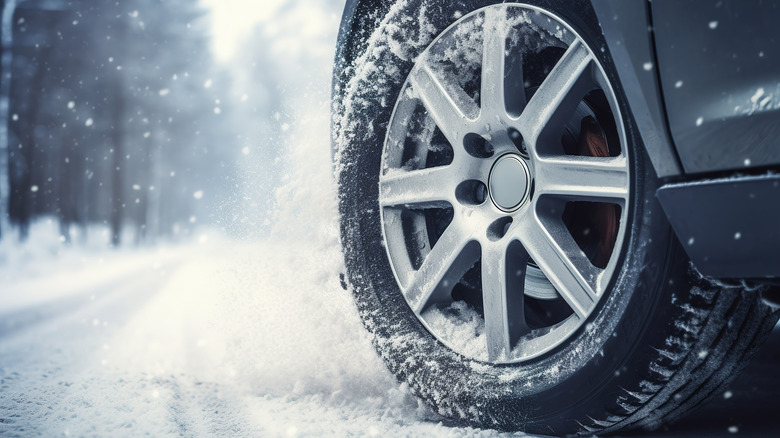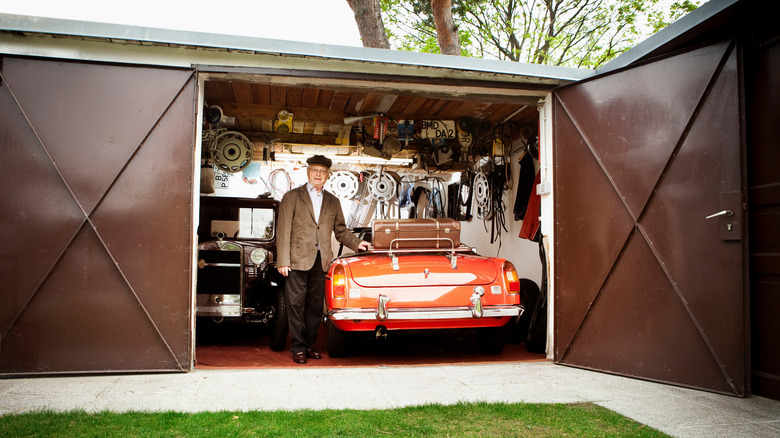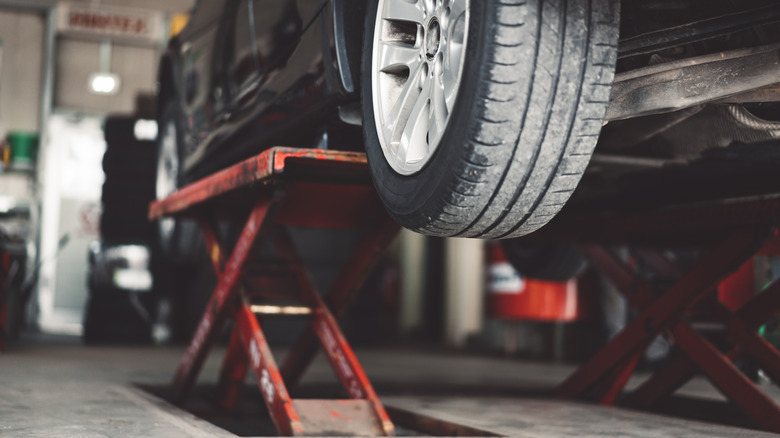How To Prevent Flat Spots On Tires During Storage
The lower a vehicle tire's pressure, the more susceptible it is to developing a flat spot. Naturally, then, you'll want to be sure to keep on top of those levels prior to storage. Don't over-inflate your tires (that risks compromising performance and an increased chance of them blowing or other dangerous failures), but ensure they're in top driving condition before you pack them/your car away. If you're careful to do so, they have a better chance of still being in that condition when you need them again.
Flat spots can develop from the constant pressure of the ground and the car's weight. Since the wheel isn't turning, the part of the tire on the floor bears the brunt of everything. If you have access to jack stands, use them to keep your tires elevated. Depending on where your vehicle is being stored, this may not be possible. In these cases, where risks can't be prevented entirely, they can be reduced. Use tire cushions — which have the advantage of being able to be used almost anywhere — to provide tires with a less harsh surface.
Though flat spots tend to be short-lived, some can be more stubborn and problematic. This guide will explain how to rid your tires of them if they develop, what to do about "permanent' flat spots, and the factors that can cause them in the first place.
The dangers of permanent flat spots
If your vehicle is less sleeping for the night and more preparing to hibernate for the winter, you'll want to take greater care to protect it for a longer period in storage. Doing so can reduce the chance of flat spots occurring. Such spots, while they'll typically vanish again after the vehicle has been driven once more, can affect performance for a period and are best avoided where possible.
Michelin reports that a flat spot that has formed in a tire in storage will generally correct itself within around 20 minutes of renewed driving. One caused by wear, however, will not, and could potentially be very dangerous. Therefore, drivers must be vigilant about checking their tires and having them maintained if anything looks amiss. Such signs could include visible wear or damage in patches, an unfamiliar vibration as the vehicle is being driven, or a noticeable diminishment in brake performance.
Permanent flat spots can be created when a tire is worn unevenly through acts such as sudden, heavy braking. Literally burning rubber can have dire repercussions for a driver, affecting performance and traction. As with a bald spot on a tire, lacking tread anywhere on the surface compromises control, which can be fatal. With permanent flat spots, it's crucial to seek professional advice and replace the affected tire(s) immediately.
Flat spots from storage, meanwhile, can become more severe the longer a vehicle is stored. In the next slide, we'll see why this is and exactly how flat spots form.
How to stop the inconvenience of flat spots
Flat spots that surface while a vehicle is stored away are typically different from specific worn patches on a tire. The former are often created by changing temperatures. As cars are driven, particularly in warm weather, their tires can expand. They will then recede again as the driver parks up. In doing so, their shape can shift to accommodate the ground the vehicle is parked on. This, then, is a primary cause of a flat spot (and of it righting itself again once the vehicle is back on the road), and they'll announce their presence with an uneven feeling in that specific area while the wheels are in motion. Similarly, temperature shifts in the environment where the vehicle is stored can make flat spots more likely.
The weight of the vehicle on that one section of tire can have a greater effect over longer periods. Semi-permanent flat spots are rare, caused by protracted periods of storage (weeks or months versus days), but it usually requires servicing to resolve the issue — the tire generally won't simply return to its familiar shape after returning to the road.
Regular maintenance of your tires, keeping on top of balancing, pressure, and rotating are valuable weapons against flat spots. On top of that, always consider how long your vehicle will be in storage and prepare accordingly.


